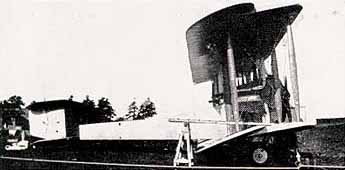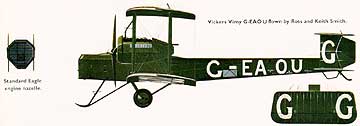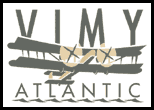I'm always looking for new Vimy information to add to
the Web site. Recently, I obtained a copy of Profile Publications,
Ltd. pamphlet #5 titled "The Vickers F.B. 27 Vimy,"
written by J.M. Bruce and published in 1965. The pamphlet
has a wealth of information about the Vimy's development,
with many photos and drawings of actual Vimy aircraft.
I've been trying for about two weeks to track down the
publisher and author to get reprint permission but, so
far, have been unsuccessful. I will keep trying. (If anyone
out there can help me get permission—or at least
point me in the right direction—please do!) In the
meantime, I decided that an excerpt about the Vimy's historic
flights, taken from the end of the publication, would
probably be okay. Here it is.
Although the Vimy's R.A.F. career was unspectacular,
it gained immortality by its successes in early long-rang
flights. The Vimy's first achievement in this field,
the first Atlantic direct crossing, as of such a magnitude
that it almost eclipsed the other two major flights.
 The
aircraft in which Captain John Alcock, D.S.C., and Lt.
Arthur Whitten-Brown covered the 1,890 miles between
Lester's Field, St. Johns, Newfoundland and Clifden,
Co. Galway, Ireland, was specially built for the Atlantic
flight. Its engines were two 360-h.p. Rolls-Royce Eagles
VIII; additional tanks increased its fuel capacity to
865 gallons and gave the aircraft a range of 2,440 miles.
The nose cockpit was faired over, and the pilot and
navigator sat side-by-side in the main cockpit; behind
them an enlarged turtle-back fairing extended over the
fuel tanks. In place of the nose skid, a wheel was fitted,
but it and the tailplane skids were removed for the
Atlantic flight.
The
aircraft in which Captain John Alcock, D.S.C., and Lt.
Arthur Whitten-Brown covered the 1,890 miles between
Lester's Field, St. Johns, Newfoundland and Clifden,
Co. Galway, Ireland, was specially built for the Atlantic
flight. Its engines were two 360-h.p. Rolls-Royce Eagles
VIII; additional tanks increased its fuel capacity to
865 gallons and gave the aircraft a range of 2,440 miles.
The nose cockpit was faired over, and the pilot and
navigator sat side-by-side in the main cockpit; behind
them an enlarged turtle-back fairing extended over the
fuel tanks. In place of the nose skid, a wheel was fitted,
but it and the tailplane skids were removed for the
Atlantic flight.
At Vickers there was at one time some division of opinion
as to whether one or two special Vimys should be built.
The pressing need to make haste settled the matter,
however, and only one was constructed. Such was the
simplicity and speed of aircraft design work at the
time that Rex Pierson wrote on 21st February 1919: "At
present I am getting out drawings of (1) New oil tanks,
(2) New water tank of increased capacity, (3) Petrol
system, and I hope to let muller have these by tomorrow
morning.
Alcock made the first test flight in the Vimy on 18th
April 1919, and he and Brown made several flights in
it before it was dismantled and shipped to Newfoundland.
After overcoming many difficulties, not the least of
which was the finding of a field suitable for the take-off,
the Vimy was airborne at 4.13 p.m. (G.M.T.) on 14 June
1919, and cross the Newfoundland coast fifteen minutes
later. At 8:40 a.m. (G.M.T.) on the following day it
landed in Derrygimla Bog, Clifden, damaging the lower
wings and the forepart of the fuselage. The Vimy as
repaired and presented to the Science Museum, South
Kensington, in December 1919; it can still be seen there.
In November 1919 another Vimy began another historic
long-distance flight. A price of £10,000 had been
offered in March 1919 by the Australian Government for
the first flight made by Australians from Britain to
Australia in a British aircraft. It was stipulated that
the flight must be accomplished within 720 hours, and
the take-off was to be made from Hounslow aerodrome
or Calshot seaplane station.
 In
view of the Vimy's recent Atlantic conquest, it was
natural that Vickers should enter an eaircraft of the
same type for the Australian flight. The Vimy selected
was F8630, which was given the civil identity G-EAOU;
this registration was irrevently interpreted as meaning
"God 'elp all of us." The pilot was Captain
Ross Smith, the redoubtable "Hadji" of No.
1 Squadron, Australian Flying Corps, adn a Bristol Fighter
pilot of distinction; his brother Lt. Keith Smith was
navigator; and their mechanics were Sgts. J.M. Bennett
and W.H. Shiers.
In
view of the Vimy's recent Atlantic conquest, it was
natural that Vickers should enter an eaircraft of the
same type for the Australian flight. The Vimy selected
was F8630, which was given the civil identity G-EAOU;
this registration was irrevently interpreted as meaning
"God 'elp all of us." The pilot was Captain
Ross Smith, the redoubtable "Hadji" of No.
1 Squadron, Australian Flying Corps, adn a Bristol Fighter
pilot of distinction; his brother Lt. Keith Smith was
navigator; and their mechanics were Sgts. J.M. Bennett
and W.H. Shiers.
Ross Smith took off from Hounslow at 8 a.m. on 12 November
1919 and G-EAOU had an adventurous journey before reaching
Darwin at 4.10 p.m. on 10th December. The 11,130 miles
from Hounslow had been covered in just under twenty-eight
days elapsed time, 135 hrs. 55 mins. flying time.
Vickers Ltd. presented G-EAOU to the Australian Government.
It was allotted the Australian serial A5-1, but it is
doubtful whether the aircraft ever bore this marking.
It was exhibited in the Australian War Memorial at Canberra
until 1957, when it was moved to Adelaide to form the
centre of a memorial to the four men who had made the
first flight to Australia. Although severely damaged
by fire on 3rd November 1957 while in transit from Caberra,
the Vimy was carefully restored and installed in the
memorial.
 The
third long-distance flight undertaken by a Vimy began
on 4th February 1920, when Lt. Col Pierre van Ryneveld,
D.S.O., M.C., and Major C.J. Quintin Brand, D.S.O.,
M.C., D.F.C., with two mechanics, took off from Brooklands
bound for Cape Town. The flight was sponsored by the
South African Government; the aircraft was an Eagle-powered,
registered G-UABA and named Silver Queen; the
prize was again £10,000, put up by the Daily
Mail for a flight from Cairo to Cape Town. The Silver
Queen had as competitors the Handley Page 0/400 G-EAMC
and the Vickers Vimy Commercial G-EAAV.
The
third long-distance flight undertaken by a Vimy began
on 4th February 1920, when Lt. Col Pierre van Ryneveld,
D.S.O., M.C., and Major C.J. Quintin Brand, D.S.O.,
M.C., D.F.C., with two mechanics, took off from Brooklands
bound for Cape Town. The flight was sponsored by the
South African Government; the aircraft was an Eagle-powered,
registered G-UABA and named Silver Queen; the
prize was again £10,000, put up by the Daily
Mail for a flight from Cairo to Cape Town. The Silver
Queen had as competitors the Handley Page 0/400 G-EAMC
and the Vickers Vimy Commercial G-EAAV.
On 10th February 1920 van Ryneveld and Brand left Heliopolis
after dark; next day, when they were 530 miles from
Cairo and still eighty miles short of Wadi Halfa, the
radiator tap on the Starboard engine opened, the egine
soon stopped, and an emergency landing was made at Korosko.
The Vimy was wrecked on the boulder-strewn ground, but
the crew unhurt.
At the request of the South African Government the
Royal Air Force placed another Vimy at the disposal
of van Rynevenld and Brand. The engines and instruments
of Silver Queen were salvaged and returned to
Cairo for installation in the replacement aircraft,
which was named Silver Queen II. The new Vimy
took off from Heliopolis on 22nd February; Bulawayo
was reached one week later, but there Silver Queen
II was wrecked while taking off for Pretoria, her
take-off performance having been greatly reduced by
heat and the altitude of the aerodrome at Bulawayo.
Again van Rynveld and Brand were unhurt, and they completed
their flight to Cape Town in the D.H.9 H5648, reaching
their destination on 20th March.
The photos and drawing here are also taken from the pamphlet.
The color drawing is © R. Ward and is just an excerpt
from a page that includes five different Vimys.
This is just a short excerpt from the pamphlet. The remaining
information details Vimy development and provides information
about configurations. If you're interested in obtaining
a copy, I suggest searching the Internet with a search
phrase like "Profile Publications Vimy" to locate
bookstores and hobby shops with used copies for sale.
I paid about $10 with shipping for my copy and it's in
excellent condition.


